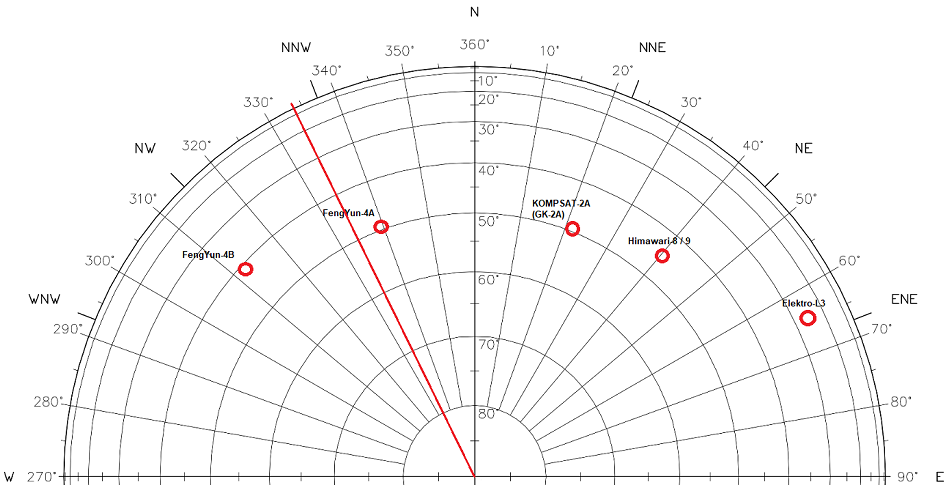|
WEATHER
SATELLITES - GEOSTATIONARY - L BAND
Geostationary weather satellites that transmit in
the 1.7 GHz (L Band) Under
development
HOME >
OPERATIONAL
> MODES
& FREQUENCIES >
Table
of geostationary weather satellites that transmit in the 1.7 GHz
band.
|
Satellite
|
Azimuth
(° True)
|
Elevation
(°)
|
L-band
Frequency Range (MHz)
|
Typical
Data Service
|
Polarization
(Receive)
|
Notes
/ Remarks
|
|
Geo-KOMPSAT-2A
(GK-2A)
Korea
|
21.3°
|
51.1°
|
1692.14
(LRIT)
1695.40 (HRIT)
|
HRIT
/ LRIT
|
RHCP
|
Stable,
continuous HRIT broadcast; very popular in Asia-Pacific.
|
|
Himawari-8
/ 9
Japan
|
40.4°
|
44.9°
|
1691–1694
|
HRIT
/ LRIT
|
RHCP
|
HimawariCast
L-band service (via JMA); identical polarization to GK-2A.
|
|
FengYun-4A
(FY-4A)
China
|
338.5°
|
51.0°
|
1687
(LRIT)
1695 (HRIT)
|
HRIT
/ LRIT
|
RHCP
|
Strong
continuous transmission; good coverage for WA.
|
|
FengYun-4B
(FY-4B)
China
|
312.1°
|
40.8°
|
1687–1695
|
HRIT
/ LRIT
|
RHCP
|
Operational
sibling to FY-4A; similar signal parameters.
|
|
Elektro-L3
Russia
|
65.6°
|
26.0°
|
1691–1693
|
HRIT
/ LRIT
|
RHCP
|
Lower
elevation from WA but still above horizon; transmissions may
be intermittent.
|
Table
1 Details of various geostationary weather satellites that transmit in the
1.7 GHz band as viewed from Northam West Australia.

Fig
1 Sky view of various geostationary weather satellites that transmit in the
1.7 GHz band as viewed from Northam West Australia.
Hardware
setup
|
Item |
Typical
Spec / Recommendation |
|
Antenna
|
1–1.2
m parabolic dish or 3–5 turn RHCP helical tuned for 1.69 GHz
|
|
Feed
Polarization
|
Right-Hand
Circular (RHCP)
|
|
LNA
|
≤
1 dB noise figure, ≥ 20 dB gain, placed near feed
|
|
SDR
|
RTL-SDR
V3, Airspy Mini, SDRplay, or similar (TCXO/GPSDO preferred)
|
|
Coax
|
Low-loss
(LMR-240/400 or RG-6); keep length ≤ 10–15 m
|
|
Power
|
Bias-T
to power the LNA (5–12 V depending on model)
|
DISH
ANTENNA - 1.7GHz
0.9m
Satellite
Dish Antenna - 1.7 Ghz.
Notes
for SatDump Users
SatDump
general parameters
|
Setting |
Recommended
Value / Notes |
|
Input
source |
Your
SDR (select correct driver) |
|
Centre
Frequency |
See
per-satellite table below |
|
Sample
Rate |
2.4
MS/s – 6 MS/s (depends on SDR and PC speed) |
|
Gain |
Adjust
so the LRIT/HRIT carrier peak is 30–40 dB above noise floor |
|
Demodulator |
BPSK
(CCSDS BPSK or OQPSK depending on satellite preset) |
|
Pipeline |
Select
Satellite Service: LRIT or HRIT |
|
Output
Folder |
e.g.,
SatDump/output/ |
|
Clock
correction |
Enable
Frequency correction if your SDR has slight drift |
|
Recording |
Optional:
save IQ stream for later decoding (tick Record IQ) |
Pass
Prediction Tools
To
predict when the satellite will be overhead:
TOP
OF PAGE
Page initiated 18
October,
2025
Page
last revised 18 October,
2025
|